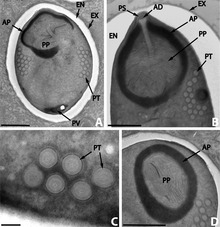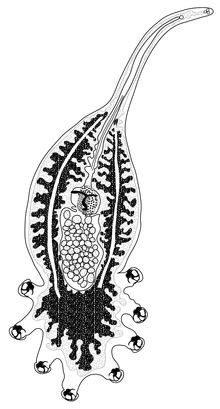

A hyperparasite, also known as a metaparasite, is a parasite whose host, often an insect, is also a parasite, often specifically a parasitoid. Hyperparasites are found mainly among the wasp-waisted Apocrita within the Hymenoptera, and in two other insect orders, the Diptera (true flies) and Coleoptera (beetles). Seventeen families in Hymenoptera and a few species of Diptera and Coleoptera are hyperparasitic. Hyperparasitism developed from primary parasitism, which evolved in the Jurassic period in the Hymenoptera. Hyperparasitism intrigues entomologists because of its multidisciplinary relationship to evolution, ecology, behavior, biological control, taxonomy, and mathematical models.
Examples

The most common examples are insects that lay their eggs inside or near parasitoid larvae, which are themselves parasitizing the tissues of a host, again usually an insect larva.
A well-studied case is that of the small white butterfly (Pieris rapae), a serious horticultural pest of Brassica species such as cabbage and Brussels sprouts. Its larvae are parasitized by the larvae of the wasps Cotesia glomerata and C. rubecula, both of which are in turn parasitized by the wasp Lysibia nana.
Plant volatiles are emitted from plants as a defense against herbivory. The volatiles emitted attract parasitic wasps that in turn attack the herbivores. Hyperparasitoids are known to find their victims through herbivore-induced plant volatiles emitted in response to attack by caterpillars that in turn had been parasitized by primary parasitoids. The larvae of parasitic wasps developing inside the caterpillar alter the composition of the oral secretions of their herbivorous host and thereby affect the cocktail of volatiles the plant produces. The pupae of primary parasitoid species are parasitized by many hyperparasitoid species.
Hyperparasites are not limited to insects. There are parasitic flatworms that are parasite on crustaceans, themselves parasite on fish. An example is the monogenean Cyclocotyla bellones, found on Ceratothoa parallela, a cymothoid isopod parasite of the sparid fish Boops boops.
Number of levels
There are further levels of parasitoids, beyond secondary, especially among facultative parasitoids. Three levels of parasitism have been observed in fungi (specifically, a fungus on a fungus on a fungus on a tree).
Effect on prey
Hyperparasites can control their hosts' populations, and are used for this purpose in agriculture and to some extent in medicine. The controlling effects can be seen in the way that CHV1 virus helps to control the damage that chestnut blight, Cryphonectria parasitica, does to American chestnut trees, and in the way that bacteriophages can limit bacterial infections. It is likely, though little researched, that most parasitic (disease-causing) micro-organisms have hyperparasites which may prove widely useful in both agriculture and medicine.
Hyperparasitism is to an extent analogous to predation on herbivores, which in turn eat plants, as there are three trophic levels involved. However, hyperparasites are smaller than predators, breed more rapidly than their hosts and are generally found in larger numbers, while especially in the case of micro-organisms, their hosts can sometimes clear their infection. Hyperparasitism may thus behave differently from three-level predator-prey systems: predators can exert control of prey populations, for instance as keystone species, but given the differences between hyperparasites and predators, their effects may need to be modelled differently.
| Attribute | Hyperparasite system | Apex predator system |
|---|---|---|
| Example lower trophic level | Human (ill) | Grassland, forest (overgrazed) |
| Example middle trophic level | Vibrio cholerae bacteria | Herbivore, e.g. moose or antelope |
| Example top trophic level | JSF4 bacteriophage virus | Predator, e.g. wolf or lion |
| Controlling effect | Virus kills bacteria, allows human recovery |
Predator kills herbivores, allows ecosystem recovery |
| Size of top level organism | Very small | Large |
| Rate of top level organism reproduction | Faster than their hosts | No faster than their prey |
| Population size of top level organism | Large numbers | Small numbers |
| Reversibility of effect | Possible, infection may clear | Not possible, prey killed |
In literature
Jonathan Swift refers to hyperparasitism in these lines from his poem "On Poetry: A Rhapsody":
So nat'ralists observe, a flea
Hath smaller fleas that on him prey;
And these have smaller fleas to bite 'em.
And so proceeds ad infinitum.
See also
Notes
- Parasitoidism is now treated as one of six evolutionary strategies within parasitism.
References
- Toguebaye, Bhen Sikina; Quilichini, Yann; Diagne, Papa Mbagnick; Marchand, Bernard (2014). "Ultrastructure and development of Nosema podocotyloidis n. sp. (Microsporidia), a hyperparasite of Podocotyloides magnatestis (Trematoda), a parasite of Parapristipoma octolineatum (Teleostei)". Parasite. 21: 44. doi:10.1051/parasite/2014044. PMC 4150386. PMID 25174849.
- "Hyperparasite". Biology Online Dictionary. Retrieved 16 April 2018.
- ^ Poulin, Robert; Randhawa, Haseeb S. (February 2015). "Evolution of parasitism along convergent lines: from ecology to genomics". Parasitology. 142 (Suppl 1): S6 – S15. doi:10.1017/S0031182013001674. PMC 4413784. PMID 24229807.
- ^ Sullivan, Daniel J. (2009). "Hyperparasitism". Encyclopedia of Insects. pp. 486–488. doi:10.1016/B978-0-12-374144-8.00138-7. ISBN 9780123741448.
- Poelman, Erik H.; Bruinsma, Maaike; Zhu, Feng; Weldegergis, Berhane T.; Boursault, Aline E.; Jongema, Yde; van Loon, Joop J. A.; Vet, Louise E. M.; Harvey, Jeffrey A. (November 27, 2012). "Hyperparasitoids Use Herbivore-Induced Plant Volatiles to Locate Their Parasitoid Host". PLOS Biology. 10 (11): e1001435. doi:10.1371/journal.pbio.1001435. PMC 3507920. PMID 23209379.
- Yong, Ed (2012-11-27). "Enter the hyperparasites – wasps that lay eggs in wasps that lay eggs in caterpillars". Archived from the original on 2012-12-12. Retrieved 3 December 2012.
- Poelman, Erik H.; Bruinsma, Maaike; Zhu, Feng; Weldegergis, Berhane T.; Boursault, Aline E.; Jongema, Yde; van Loon, Joop J. A.; Vet, Louise E. M.; Harvey, Jeffrey A.; Dicke, Marcel (27 November 2012). Agrawal, Anurag A. (ed.). "Hyperparasitoids Use Herbivore-Induced Plant Volatiles to Locate Their Parasitoid Host". PLOS Biology. 10 (11): e1001435. doi:10.1371/journal.pbio.1001435. PMC 3507920. PMID 23209379.
- Bouguerche, Chahinez; Tazerouti, Fadila; Gey, Delphine; Justine, Jean-Lou (2021). "Triple barcoding for a hyperparasite, its parasitic host, and the host itself: a study of Cyclocotyla bellones (Monogenea) on Ceratothoa parallela (Isopoda) on Boops boops (Teleostei)". Parasite. 28: 49. doi:10.1051/parasite/2021044. ISSN 1776-1042. PMC 8183466. PMID 34096866. [REDACTED]
- "Fungi Cubed" (PDF).
- ^ Parratt, Steven R.; Laine, Anna-Liisa (January 2016). "The role of hyperparasitism in microbial pathogen ecology and evolution". The ISME Journal. 10 (8): 1815–1822. Bibcode:2016ISMEJ..10.1815P. doi:10.1038/ismej.2015.247. PMC 5029149. PMID 26784356.
- Swift, Jonathan (1733). On Poetry: A Rapsody. And sold by J. Huggonson, next to Kent's Coffee-house, near Serjeant's-inn, in Chancery-lane; at the bookseller's and pamphletshops. Retrieved 20 May 2013.